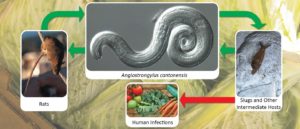Angiostrongylus or rat lungworm is a parasitic nematode commonly found in Florida and Southeast of United States. Several cases of rat lungworm are transmitted through snails and rats. These worms choose these animals as host and sometimes they live as host in human beings also. In rare cases these worms can cause severe complications. After getting transmitted to humans these worms become incapable of reproduction and will die gradually. As per the report given by the CDC Southeast Asia and Pacific regions are vulnerable for rat lungworm. Some cases have also been reported in Hawaii, Louisiana and Cuba. Sometimes these worms choose different hosts to lead their life.
Mode Of Transmission :
Rat lungworms are parasites that choose snails or rats or mollusks as their host. Rats may eat infected snails which then become the host for worms. And the worms are transmitted into the body of humans when they eat infected snails or frogs which then enter into the blood and eventually passed on to the brain.
Angiostrongylus cantonensis is the species of worm that infects the rat and hence this disease is known as Angiostrongylus. Often these parasites would die within the host and cannot multiply and hence do not cause severe infection. Only in rare cases and when the immunity is weak this disease can cause complications. Since these worms lives in the pulmonary arteries of the rats and affects their lungs it is known as rat lungworm.
Signs and Symptoms :
- Initial symptom can start from the first to third week of getting infected. Most of the signs resemble that of viral fever and go unnoticed.
- Some of the symptoms of rat lungworm are mild to moderate fever, stiffness in neck and headache. It can cause nausea and vomiting and loss of appetite.
- In severe case of infection, the individual’s brain get infected causing complications like impairment of refluxes, abnormal feeling and sensations, muscle weakness and even loss of consciousness. In rare cases the central nervous system can get infected affecting the primary nerves.
- In rare cases these worms may infect the eyes warranting surgery to avoid complication like loss of sight.
- In rare cases they may enter the brain through bloodstream causing meningitis or even coma.
- The above signs may continue for 4-6 weeks if left untreated.
Causes :
It is the parasite by name Angiostrongylus cantonensis that causes this infection. The worms reside in the body of rats or snails and may enter the human body when they eat infected animals. Eggs of these worms would remain in the body of rats and are discharged through feces. Snails may accidentally consume these droppings and worms get transmitted into the body of snails.
In such cases snails are considered to be the transporting hosts wherein the larvae of the worm would complete its life cycle. While eating uncooked snails or frogs these worms can enter into the human body. Like other infection, these worms cannot spread from one (infected) person to the other.
Tests :
There is no concrete diagnosis available for rat lungworm. Based on the symptoms of the patient and travel history and what they have consumed recently diagnosis is made.
Treatment :
No specific drug can be prescribed for rat lungworm. Drugs are given to reduce the symptom and to build immunity. According to the report of the Hawaii State health Department, a person cannot become immune to the worm once he develops rat lungworm. In other words, the same person can develop this disease many times if he/she eats infected animals. Very often, the infection settles over time (3-4 weeks) since the worms would die eventually.
Tips For Prevention :
- Practice good hygiene before eating anything and after using the toilet.
- Avoid eating undercooked snails or frogs.
- Avoid touching the snails by your finger since the worm can enter the body through your skin or even nails.
- There is every chance for the infection to spread through fishes and hence ensure that you buy and eat fishes of good quality.

